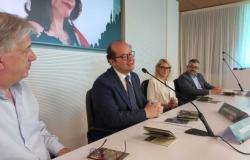In Rocca di Cambio, Saint Lucia is celebrated on Saturday and Sunday of the last week of June. The solemn Holy Mass in the Abbey of Santa Lucia will be celebrated at 11.30 by D. Luigi Abid Sid, coadjutor of the Basilica of Collemaggio in L’Aquila
Abruzzo is rich in places of intense spirituality due to its extraordinary concentration of abbeys and monasteries, churches, art treasures and mystical places frequented by saints and preachers, blesseds and hermits. Santa Lucia in Rocca di Cambio, Santa Maria ad Cryptas in Fossa, San Pellegrino in Bominaco, the convents of Sant’Angelo and Santo Spirito d’Ocre: a collection of artistic and religious wonders comparable only to the lands of Umbria around Assisi.
The feast of Saint Lucia in Rocca di Cambio today
Rocca di Cambio it is a village of medieval origin located in the northern part of the Altopiano delle Rocche, a vast plateau that extends from Monte Cagno to Monte Rotondo immersed in the enchanting scenery of the Sirente-Velino Regional Park. True sentinel of the Rocche, the municipality in the province of L’Aquila is only 17 km from the capital and, with its 1433 meters above sea level, has earned the title of highest municipality in the Apennines. Right here on Saturday and Sunday of the last week of June it is a tradition to celebrateSaint Luciathe saint from Syracuse who with her shining example of life brings light back to the days of the winter solstice, December 13th. Since 1794 it was decided to move the date of the celebrations to the summer period due to the extreme harshness of the climate of the area and the objective difficulties encountered in carrying out the procession. Just outside Rocca di Cambio, in fact, is the most beautiful treasure of Abruzzo dedicated to the saint: the Abbey of Santa Lucia, with its extraordinary pictorial cycle that covers, like a wonderful colored carpet, the ancient interiors, shining after the recent restoration. It is the great celebration of the entire Altopiano delle Rocche: during the days of the patronal feast the sanctuary is visited by many pilgrims, most of them coming from Marsica, which requires the celebration of numerous masses from morning until closing time.
The procession and the laying of the wreath to the Fallen of all wars at Piazza Maggiore Lolli and the floral tribute at the Parco della Rimembranza are traditional. The solemn holy mass at 11.30 will be celebrated at the Abbey of Santa Lucia by D. Luigi Abid Sid and enlivened by the “Schola Cantorum” of Rocca di Cambio. At 1.00 pm, the floral tribute will follow at the lake dedicated to Santa Lucia, whose waters are believed to have a beneficial effect, for this reason flowers are laid in honor of the saint and it is customary to wet one’s eyes with the spring waters that feed the lake. The procession will then return to the town with a fireworks display. At 10.30 pm, the Rocca night will be lit up by the characteristic “Ballo della Pupazza” in the main square.
The Abbey Church of Santa Lucia
Damaged during the earthquake of 6 April 2009, the church of Santa Lucia was the subject of long restoration works and was reopened for worship ten years later, in 2019. Its foundation dates back to the 11th-12th century, in the middle of the monastic era, at the time in which the bishop of Valva came into possession of the relics of the martyr and her cult was spread in the dependencies; but certain information has only been available since 1313. The cult of Saint Lucia is then linked to her work as a healer, having over the centuries become a protector of the eyes in popular use, a belief that is still perpetuated today in the ritual of the pond . Although it is commonly called an abbey, of the entire complex of buildings for the daily life of the monks only the church survives. In the eyes of the pilgrim, the sober façade presents a portal dating back to the 15th century; once inside, you discover the interior in Romanesque style and divided into three naves which houses valuable frescoes from different eras, dating back to the end of the 14th and the beginning of the 15th century. The paintings reproduce scenes from the life of Saint Lucia and stories from the New Testament which develop on horizontal bands, as in the oratory of San Pellegrino in Bominaco and in the church of Santa Maria ad Cryptas in Fossa. Everything seems to suggest a ring-shaped visit route: starting from the entrance, crosses the left nave, reaches the transept, runs across it and finally returns to the starting point through the other nave.
The feature of the church that immediately catches the eye is the unusually large presbytery, decorated with a very rich cycle of 14th century frescoes. You are impressed by theLast Supper, which occupies practically the entire northern wall, where the blessing Christ is unusually placed at the head of the table, on the far left and not in the center. To represent a unique it is instead a series of details: the figure of is missing Down from, perhaps frescoed, but then erased, as would suggest a gap in the fresco and the presence of Paul and Barnabas, protagonists of the Acts of the Apostles, but certainly absent at the Last Supper, which among other things takes place on a richly decorated table laid out. To the right of the Last Supper there is a place the fresco with the patron saint, Saint Luciatogether with the Virgin and Child. The surprises do not end here: to the right of the Madonna appears a saint in pontifical robes, whose face has been disfigured: someone wanted to see in him the features of Celestino V who took off his pontifical robes on the very day of Saint Lucia, on that fateful 13th December 1294. From the central nave you can access, via a steep staircase, the cryptwhich contains the remains of the original shepherds’ church. Here you can admire the traces of two frescoes, with the beautiful faces of a Madonna, attributed to Andrea Lithium and a Saint Lucia by an unknown author.
Stories and beauties from the village
Probably the first settlement nucleus of Rocca di Cambio was located right near the current abbey of Santa Lucia, built following the arrival of the Lombards, between the 6th and 9th centuries, in the L’Aquila valley. According to another version it was founded by the inhabitants of Forcona and Aveia in the year 591 to escape the aims of the Lombard duke Ariulfo. The first written sources, dated between the 10th and 11th centuries, report the name of the town as Rocca Ottonesca, in honor of the emperor Otto II of Bavariawho had come to Marsica for a few days’ visit to the extreme south of his dominions. Otto II fell in love with these lands, so much so that he decided to build a castle at the foot of Monte Rotondo and return there for hunting trips.
The small urban settlement, with the previous name of Rocca di Cagno, participated in the foundation of Aquila in 1254together with the other castles and settlements in the area, at the foundation of Aquila and changed its name to Rocca di Cambio only in 1268. In 1294, by will of Pope Celestine V, it was incorporated into the county of L’Aquila, receiving the privileges of Charles II of Anjou. In 1423, loyalty to the Angevins would cost Rocca di Cambio dearly, as it would be occupied and sacked by the troops of Ram’s Arm. In the 16th century the fortress initially underwent a period of Spanish domination and then passed under the control of the Colonna family; only in 1895 did the Municipality acquire complete autonomy. The traditional economy of the town was based on sheep farming and craftsmanship: the great frequenters of the plateau were in fact the shepherds, in search of pastures and abundant water. Today the main resource is certainly tourism, both winter and summer, given the proximity to one of the best known and most popular ski centers in Abruzzo, Happy Camp.






